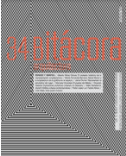A graphic image has a communicative power superior to any building; it speaks directly to the people and, as a result, it also threatens the communicative capacity of architecture. As Venturi observed, since the 1960s the building has become the advertisement of any brand. However, in the anonymous and uniform world of objects manufactured in series within which we live, the ones we use every day are not so impersonal when they have some graphic element that gives them meaning.
The prevalence of the two-dimensionality in which we live is so ingrained in our culture that architects and designers of objects, the city and the landscape are trained to and believe that designs can be represented in two dimensions. Even models have been replaced by renderings. This conceptualization of our disciplines, however, has strong implications in the shortcomings to achieve the goal of improving the life of societies; they change the way we think and understand things. The representational tools are not neutral; the intentions of the authors and of the world in which they lived can be understood by the way in which they decided to represent their designs. The tools we use today cause us to ignore that emotional meaning is given in the actions and daily use of the inhabitants and never in a static image: plan, section, facade, or video; much less in a simulated perspective of reality. Inevitably architecture, as something habitable, will be very different from its representation in the most orthodox set of building plans. There will always be a translation process between the drawing and the building and among other works that we know almost exclusively through their representation and their influence on our proposals. It is necessary to critically note and analyze these translation processes to understand their reach.
We cannot blindly accept the instrumental aspects of our representation, we must develop a critical position towards them in order to create new tools that will allow us to expand the analysis and pursue a truly meaningful architecture. Beyond the technological potentials of current architectural representation, beyond instrumental reason, architecture needs to find ways to critically represent temporary and existential human space.
DOI: https://doi.org/10.22201/fa.14058901p.2016.34
Published: 2017-01-12

